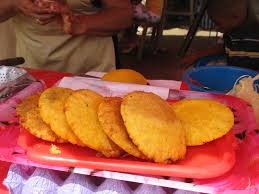 The list in my hand was as straightforward as could be: masa, black beans (canned), avocados (3), jalapeños (2), plantains (a few) and cilantro (lots). In keeping with the when-you-go-shopping-for-others ritual, an inevitable phone call came through along with a request for a few more items – limes and adobo seasoning. Naturally, this after I had already checked out.
The list in my hand was as straightforward as could be: masa, black beans (canned), avocados (3), jalapeños (2), plantains (a few) and cilantro (lots). In keeping with the when-you-go-shopping-for-others ritual, an inevitable phone call came through along with a request for a few more items – limes and adobo seasoning. Naturally, this after I had already checked out.
You see, my father was gearing up to revisit one of his many “taste sensations,” which of course means two things – several consultations over speaker phone and hours of work. Fortunately, as one of the most-retired people in Southern New England, hours are something that Bobby Pastrami has plenty of.
When not resting, watching TV, visiting the VA hospital, playing in one of two concurrent golf leagues or hollering for no particular reason, Pastrami is cooking, eating or devising plans for his next meal. On this particularly fine spring day, it was a very specific comida tipica. Admittedly, not too many musiú find themselves craving this particular dish, but then again, even fewer carry monikers attributed to an obsession they have for cured meats.
Our joint introduction to the South American delicacy came by way of the somewhat quiet Fairlawn neighborhood in Pawtucket. Since that first visit, this Venezuelan eatery has positioned itself near the top of the list of places where I take my old man for lunch.
The server/owner/cook(?) is a tall, friendly, polo-ed gentleman who suddenly – and without a sound – appears in the dining area, greets diners and immediately sets out to satisfy his end of the transaction, which more often that not begins with an offer for a beverage. Now when it comes to refreshment, the just-sweet-enough and ultra-satisfying pure sugar cane and lime juice over ice conquers thirst like a post-1992-Hugo Chavez. This most magical component of this elixir is surprisingly not what is inside, rather the actual container. This tasty liquid is always served in white foam cups – even when you are dining in.
For an appetizer we wisely go for the ripe plantains. They are prepared in a manner that consistently yields a soft, pleasantly gooey mouth feel, yet are not in the least bit devoid of flavor. The banana-like, partially caramelized flesh is paired wonderfully with traditional sauces (cilantro, cilantro, cilantro), which perfectly cut their natural starchiness.
The namesake-filled corncake is not too unlike an English muffin in consistency. It is, however, their busting-at-the-seams innards that make these traditionally prepared patties so spectacular. Pastrami takes his duo in pabellon form, with shredded beef, beans, cheese and avo. As a staunch zanahoria, mine tend to stray far from the dark path.
PROVedge Warning: I am nearly positive that my modified arepas are far from animal-byproduct-free, but I am confident that they are (mostly) vegetarian. “Frijoles negros y avocado-stuffed, no queso con a side of lettuce and tomato” is how I take mine — always in a pair (black beans and avocado without cheese with a side of… you get the rest). And yes, tradition has it that I embarrass myself while ordering in poor Venezuanglish. PROVedge Justification: I have not been exposed to the Spanish language on a consistent basis since Acapulco, Cuerpo y Alma went off the air, circa 1996. If you are curious why I watched a telenovela – on a 13” Emerson TV/VCR combo – it was because I found Patricia Manterola to be muy caliente.
Don’t get me wrong, my father’s arepas are tasty, but they lack that something special. Perhaps it is due to the luster that only La Arepa’s naranja’ed walls and styrofoam can deliver.
La Arepa Restaurant, 574 Smithfield Ave, Pawtucket. 401.335.3711, laarepari.com